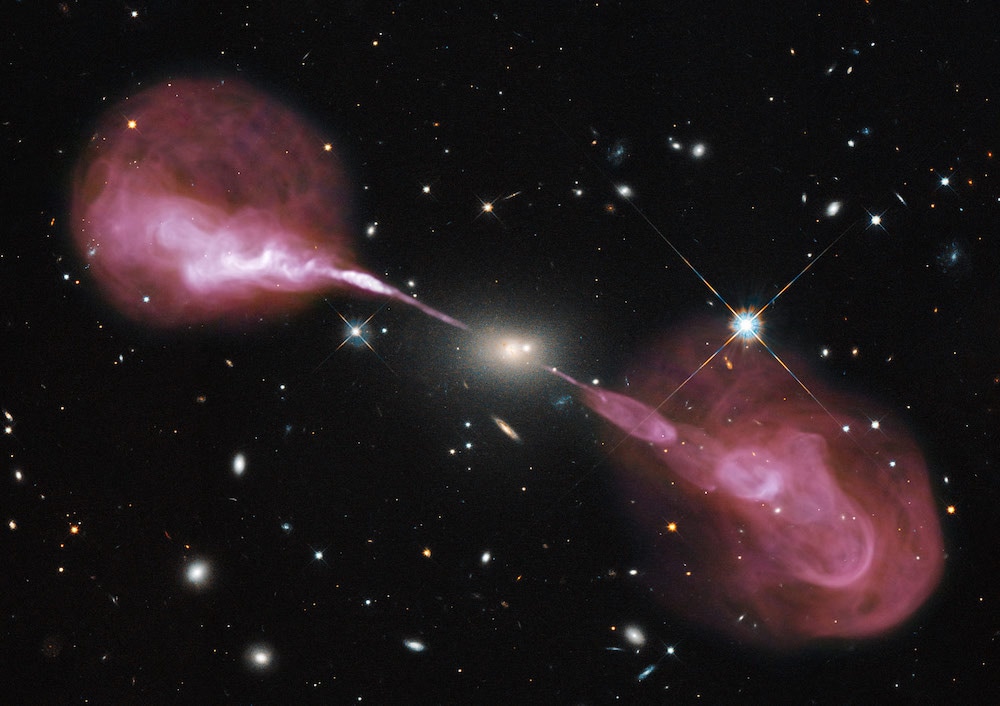Create a free profile to get unlimited access to exclusive videos, sweepstakes, and more!
The Labor of Hercules A

Black holes may be the most ironic objects in the Universe. They are objects with gravity so fierce that if you venture too close, literally no force in the Universe can prevent you from falling in. Not even light can escape, which is why we call them what we do.
Yet they also power the brightest objects in the Universe. As matter falls in, it forms a disk just outside the black hole that gets infernally hot, blasting out radiation bright enough that it can be seen across the Universe. Not only that, due to forces in the disk like friction and magnetism ramped up to mind-numbing intensities, this disk can focus and blast out two incredibly powerful beams of matter and energy which scream out into space, forming structures both vast and beautiful — like the ones seen in the galaxy Hercules A:
Seriously, grab the embiggened version of that. It's stunning. I'm using it as my computer's desktop image, in fact. There's also an incredible 5000 x 3500 pixel version.
In the heart of the galaxy Hercules A is a monster black hole: It's about 600 times as massive as the black hole in the center of our Milky Way, making it about 2.5 billion times the Sun's mass. It's one of the largest known black holes in the Universe, so big we call it "supermassive."
And it's hungry. Material is actively funneling down into the maw of that beast, forming a huge disk and blasting out those jets of material you can see in the picture (which is a combination of visible light seen by the Hubble Space Telescope and radio waves (colored pink in the image) detected by the Karl G. Jansky Very Large Array). Focused tightly, those jets march across space at ridiculously high speed, slamming into material around them. Eventually they lose enough energy that they slow and puff outward, forming those twin lobes. When this happens, the material emits light in the radio part of the electromagnetic spectrum. The lobes of Herc A make it one of the brightest sources of radio waves in the entire sky.
The scale of this will turn your brain into goo: Those lobes are well over 1.5 million light years across from tip to tip, 15 times the size of our entire galaxy! And they're powerful, emitting a billion times the energy our Sun does at radio wavelengths. The energy flowing out of Hercules A is simply insane. In X-rays alone it blasts out 100 billion times as much energy as our Sun does in all wavelengths of light. Replace our Sun with an object that bright and the Earth would vaporize.
And all of that immensity is powered by the gravity of that black hole, which, massive as it is, is only about the same size as our solar system. The galaxy you can see in the picture, right at the center of the jets, is hundreds of millions of times larger than the black hole itself.
How's your head? Throbbing yet? I have one more thing to tell you: Hercules A, while being one of the brightest radio objects in the sky, is actually over two billion light years away!
Describing this is getting difficult. I'm running out of adjectives here.
So maybe I'll just leave you with this: A century ago, we weren't sure what galaxies really were. Now we have orbiting telescopes, telescopes equipped with amazingly sensitive detectors, and the ability to see across the electromagnetic spectrum such that we can detect these amazing and powerful objects like Herc A. And even more importantly, we've built the knowledge in mathematics and physics so that we can study them and even understand them. And we can do it all from a cozy distance of billions of light years, safe and sound, while the Universe thunders around us.



























